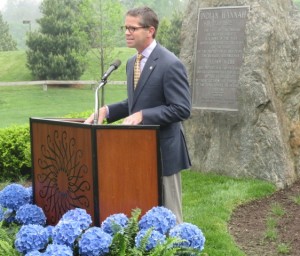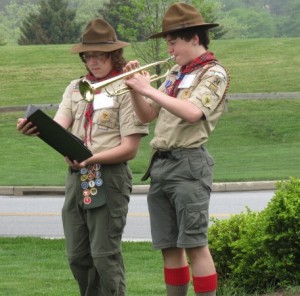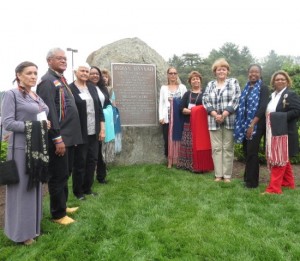Monument re-dedicated at location outside Longwood Gardens
By Kathleen Brady Shea, Managing Editor, The Times

Paul B. Redman, director of Longwood Gardens, explains what led to the relocation and rededication of the Indian Hannah monument.
With a reverence for the past and an eye to the future, state and local officials gathered at the entrance to Longwood Gardens on Thursday, May 15, to re-dedicate the monument honoring Hannah Freeman, better known as Indian Hannah, a celebrated member of the Lenni-Lenape Indians in Chester County.
Paul B. Redman, director of Longwood Gardens, explained that when Rt. 52 was relocated in 2011 to accommodate the expansion of Longwood’s Meadow Garden, the nearly 88-year-old monument “became an island,” losing its visibility. He said an effort to ensure that the memorial would be accessible involved a host of collaborators, including the Pennsylvania Historical and Museum Commission, The Chester County Historical Society, Kennett Township and the Kennett Township Historical Commission.
“Longwood could not have done this alone,” Redman said. In an effort to pay homage to the history of the monument – a bronze plaque anchored by a water-worn Pocopson Creek boulder – Redman said Wednesday’s ceremony was organized to replicate the one held on Sept. 5, 1925, and it resonated with links to the past.

Fellow Boy Scout Zachary Powell (left) holds the music as Harrison Warren plays “America the Beautiful” at the Indian Hannah rededication ceremony at Longwood Gardens.
Dennis Coker, principal chief of the Lenape Tribe of Delaware, set the tone with an evocative invocation to the Great Spirit. Calling Indian Hannah, “truly a keeper of this land,” he asked for blessings upon the multi-cultural group that assembled at the monument’s new home: the grounds of the former Progressive Friends Meeting House, now the Chester County Conference and Visitors Bureau, adjacent to the Longwood Gardens entrance.
Like the original gathering, representatives from what is now the state Historical and Museum Commission and the county’s Historical Society joined descendants of the Webb family, who owned the land in Kennett Township where Indian Hannah was born in 1730. Kenneth Vandegrift was one of four Webb descendants who participated on Wednesday; his mother unveiled the plaque in 1925.
As environmental steward Pierre S. du Pont had done decades ago, Nathan Hayward III, president of Longwood’s board, conveyed a deed for the land to Serena Bellew, director of the state Bureau for Historic Preservation. Redman noted that du Pont had a great interest in genealogy and preservation and would certainly have applauded the effort to provide a venue that offered the monument improved exposure and accessibility.
Hayward pointed out that Redman owes a debt of gratitude to the Webbs, since he now resides in a home formerly owned by their family. Another “bit of symmetry:” The year that Indian Hannah was born was the same year that the du Ponts started the lucrative gunpowder business that eventually enabled Pierre du Pont’s philanthropy, Hayward said.

Descendants of the Lenape Indians, including Chief Dennis Coker (second from left), pose in front of the Indian Hannah memorial.
Rob Lukens, president of the Chester County Historical Society, provided insight into Indian Hannah’s legacy, explaining that the myth that she was “the last of the Indians in Chester County” gained steam over the years. “There are plenty of Lenapes still here with us,” he said. In fact, some of those myth-busters attended the ceremony.
More importantly, Lukens said Indian Hannah offered a stellar example of resilience as she and others adapted to a changing – and often turbulent – landscape. In 1764, she and relatives moved to New Jersey to escape the violence, returning to Chester County seven years later. She developed close relationships with some of the Quaker families who cared for her, and she became one of the first to reside in Chester County’s Poorhouse, where she died in 1802, he said.
Claire Sawyers, director of Swarthmore College’s Scott Arboretum, read a poem written by John Russell Hayes, who was Swarthmore’s librarian when he recited it at the first dedication. In it, he describes the kind of pastoral landscapes that Longwood’s new Meadow Garden will contain.
Finally, Redman said, the task of finding a bugler presented a bit of a challenge, but the Boys Scouts came to the rescue. Harrison Warren from Boy Scout Troop 24 played a crowd-pleasing “America the Beautiful” to end the program.
Later, the serendipitous nature of the gathering continued when Coker approached Kennett Township Manager Lisa M. Moore. “You look like you could have Indian” ancestry, he told her.
Moore’s eyes widened in amazement. “Blackfoot,” she said proudly.
“We know who we are,” Coker added knowingly, reflecting a heritage the Indian Hannah monument should help to promote.




